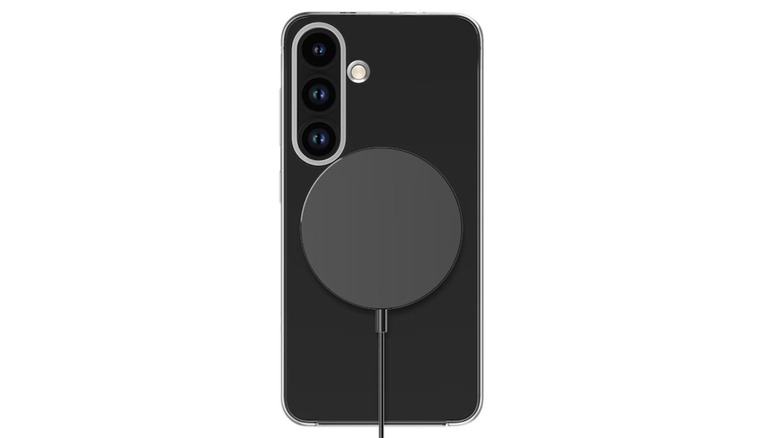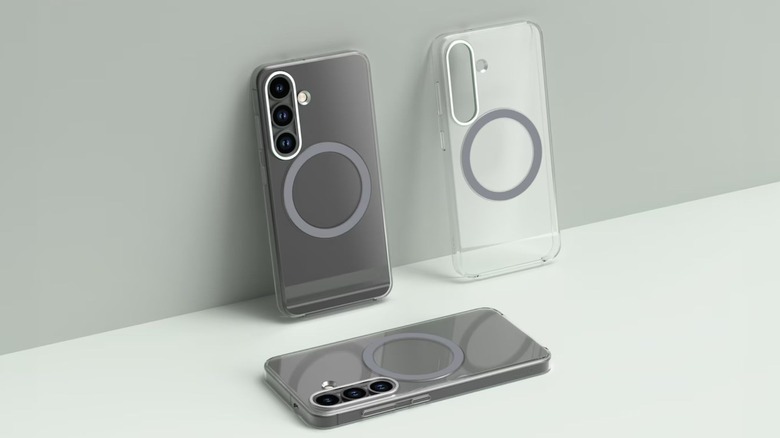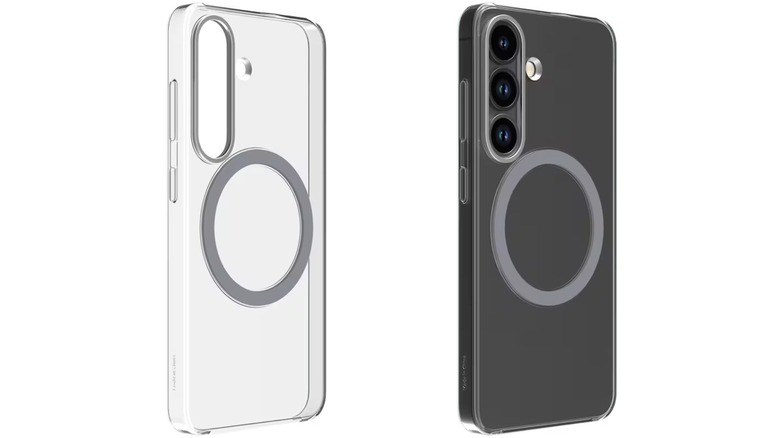Does Apple's MagSafe Charger Work With Samsung Phones?
When Apple introduced the MagSafe charging system on the iPhone 12 series, it was a conveniently novel twist on the wireless charging tech. Thanks to the addition of magnets, users were no longer worried about their phone slipping off a wireless charging pad. Nearly half a decade later, the tech has yet to become mainstream in the Android ecosystem, even though it is technically ready to support phones from brands such as Samsung.
But can a Samsung phone be charged with an Apple MagSafe charger? The answer is yes, but not directly. Magsafe is essentially a Qi wireless charging system, but with a two-way magnetic lock pathway that Apple designed. For MagSafe to work as intended, a magnetic ring is placed underneath the surface of the charging pad and within the rear glass of the phone. When the two magnets come close to each other, they lock in place, and wireless charging begins uninterrupted.
In Apple's case, all mainline iPhones launched after the iPhone 12 series come with a magnetic ring fitted around the wireless charging coil underneath their glass shell. Samsung phones, even the latest Galaxy S25 series devices, don't come with a magnetic ring fitted underneath the rear panel. But if you can spend about $30-$50 on a special case, they will play just fine with MagSafe chargers.
Bringing MagSafe convenience to a Samsung phone
The industry-wide wireless charging standard that every brand follows is called Qi. In 2023, following the success of MagSafe, the Wireless Power Consortium (WPC) introduced the next-gen Qi2 wireless charging standard. The biggest upgrade is the magnets used in the wireless charging process, just like MagSafe. To qualify as a Qi2-certified device, a phone must feature a magnetic ring. Samsung even committed to the cause.
A press statement from the Wireless Power Consortium indicated that Qi2 Samsung devices would hit shelves in 2025. Unfortunately, no such Samsung Galaxy-branded smartphone has yet appeared on the market. To combat the poor optics, the WPC created a new designation called Qi2 Ready, which includes devices and accessories that deliver the full Qi2 experience when combined. So if a phone lacks magnets beneath its glass shell, put a case with a built-in magnetic ring over it, and it's Qi2 Ready. Such magnetic cases will allow any phone that supports wireless charging to snap onto a Qi2 or MagSafe charger and draw power. These cases are made by familiar brands like Spigen, Pitaka, Otterband, and Dbrand, and even Samsung magnetic ring cases for its Galaxy smartphones.
A few things you must keep in mind
So why not just make a cheap magnetic ring of your own, glue it to a cheap case, and call it a day? According to Paul Golden, a senior executive at the WPC, a magnetic ring won't turn any smartphone into a Qi2-ready phone. "Qi2 Ready phones have 'special features built into them' to enable proper Qi2 functionality," Golden was quoted as saying by a WIRED report. While he didn't go into the technical details, the drawbacks will be visible if you expect Qi2 superpowers on a non-Qi2-ready phone, even if it supports wireless charging. You will run into a similar hurdle when putting such phones on a MagSafe charger, as well.
In terms of speed, MagSafe and Qi2 both provide a peak charging output of 15W. If your Samsung phone supports wireless charging, but it is not Qi2-ready, it will only be able to draw 7.5W output from a MagSafe charger, even if you cover it with a magnetic ring case. On the other hand, if your Samsung Galaxy smartphone is Qi2-ready and you put a case that has a magnetic ring built into it, the phone will be able to draw 15W output. Accessory-maker Casely also warns that charging speeds may be comparatively sluggish, and the effectiveness of the magnetic ring inside a case might deplete over time. Anker also warns of similar technical hiccups, adding that the workarounds might not work as effectively as a MagSafe-enabled iPhone does.


